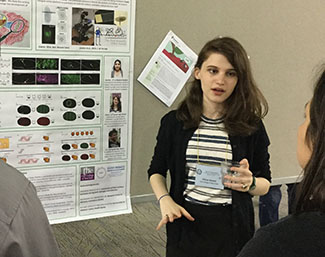Translating Drosophila
Research for K-12
Audience
By Chloe Kenet and
Michelle Juarez
Chloe Kenet is a high
school senior at the Brearley School in Manhattan,
New York. Michelle Juarez is an assistant medical
professor at The City College of New York where she
studies wound healing in Drosophila.
|
 |
|
Chloe Kenet presenting at SDB 76th Annual
Meeting in Minneapolis, MN. |
This past summer, we presented an Education Poster
at the SDB Annual meeting in Minneapolis, MN. Our
poster highlighted a recent student-centered
creative writing project. We used
Frontiers
for Young Minds as a platform to “translate” our
research into simpler text that children without an
extensive scientific education could understand.
There are many topics of papers: astronomy,
biodiversity, health, math, neuroscience, and earth
and its resources. A paper can be submitted as a
“New Discovery” of a previously published research
article or a “Core Concept” of a science topic. To
ensure that the papers are truly kid friendly, the
first draft is reviewed by a group of kids of a
specified age range (9-12).
I have been volunteering at the City College of New
York with
Dr. Michelle Juarez’s lab for a year and a half,
and one of my first projects was to rewrite
a paper for Frontiers for Young Minds. As a high
school sophomore, I was somewhat new to reading
scientific publications. This project also served as
practice for reading papers and a way to further my
understanding of what was being studied in the lab.
We started by analyzing the figures. Instead of
writing a paragraph explaining the findings, we
redrew them in multiple ways until we found the most
self-explanatory figure. We also made liberal use of
metaphors and analogies.
Explaining a professional research paper in ways
middle school students can understand is not an easy
task. When we received the feedback from the peer
review, a lot of the comments stated that the paper
was still too complex.
For the second draft of the paper, we spoke more
about the significance of working with fruit flies
and the overall meaning of our research, rather than
specifics about genetics. We compared
gain-of-function and loss-of-function mutations to a
river and dam and DNA to a blueprint for a tree
house. The kids also suggested that we add a link to
a video of our experiment:
https://www.jove.com/video/50750/microinjection-wound-assay-vivo-localization-epidermal-wound-response.
It is important to me that children have access to
scientific research papers. Younger students should
be able to learn not only about the science that
they are learning in the classroom, but also about
current research. Our paper can be found here:
http://kids.frontiersin.org/article/10.3389/frym.2016.00027.
SDB was an incredible way for me to learn about
fascinating research in developmental biology. I had
a wonderful time at the meeting this summer, and I
thank everyone for being so welcoming of a high
school student.
|